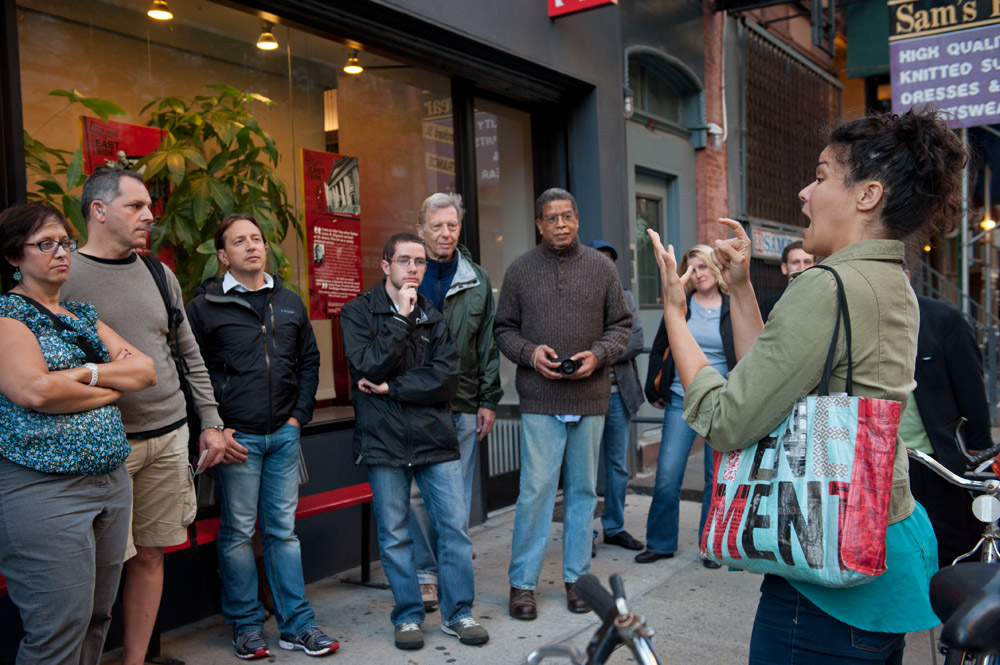Blog Archive
Accessibility at the Tenement Museum

An ASL Walking Tour offered at the Tenement Museum
July is a historic month for disability rights in America. In July of 1990, the Americans with Disability Act (ADA) was passed and signed into law by President George H.W. Bush. This landmark law requires access to goods, services, and benefits offered to the public and prohibits discriminatory exclusion because of a disability.
Since its founding, the Tenement Museum has strived to be on the forefront of accessibility and continues to welcome people of all backgrounds and abilities. There are many things we do and offer to make our institution accessible to as many visitors as possible.
To visit the Tenement Museum, you must take a guided tour. This puts the Museum in a unique position: visitors’ needs can be met more often because there is always an Educator present to work with the individuals on the tour to create a great experience for the whole group. Our Educators are trained to give tours that are accessible to a wide audience. However, we also have some tools which improve accessibility on tours. FM assistive listening devices are available upon request for all Museum programming, seating is available on all building tours, and large print and braille materials as well as handling objects are available for many programs.
One of the biggest challenges the Museum faces is physical accessibility. Our museum building – located at 97 Orchard Street – was built in 1863 and is a five-floor walk-up. Due to the historic character of our building, many features that make other museums physically accessible are not often possible at the Tenement Museum. But in 2012, the construction of a new exhibit, Shop Life, included a wheelchair lift from the sidewalk level to the basement level, making it the first wheelchair accessible tour that enters 97 Orchard Street.
While the above offerings can be helpful, sometimes more is necessary. The Museum offers several special programs designed to suit the needs of visitors with particular disabilities. American Sign Language (ASL) interpretation is available for any tour. Additionally, parties of 5 or more can schedule a Touch Tour or an ASL tour. A Touch Tour combines any of our building tours with handling objects and verbal imaging, and includes an introduction to the building using an architectural model of 97 Orchard Street. For an ASL tour, the Museum’s deaf educator, Alexandria Wailes, leads visitors on a building tour in ASL only. Private tours for visitors on the autism spectrum and their families are also available for building tours and the Meet Victoria program. For any of these private tours you must contact the Museum two weeks in advance.
Additionally, we offer ASL tours and Touch Tours for the public throughout the school year. These programs are free of charge, but reservations are required. They are a bit longer than a typical tour, can be more direct in meeting the needs of the visitors in the group, and include a reception which features local Lower East Side foods.
The offerings mentioned above do not cover all of the tools we use or programs we have that make the Tenement Museum accessible. To learn more about what we can offer or to see it in a different format, please visit the Accessibility page of our website, particularly, this handy chart.
If you have any questions about our accessible tours, or would like to talk about how we can make your upcoming visit to the Tenement Museum meet your access needs, please contact Ellysheva Zeira, Education Associate for Access, through email [email protected] or by phone 646-518-3038.
As the Tenement Museum expands with a brand new exhibit, our accessibility efforts will expand and continue as well. We will take what we’ve learned about accessibility in our current building, along with new technologies and methods, and create new programs that adhere to the highest accessibility standards.
- Post by Ellysheva Zeira, Education Associate for Access at the Lower East Side Tenement Museum